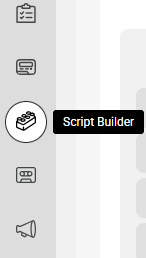Getting Started with Script Blocks
Script blocks allow you to select and customize the pieces of information SAS agents gather from your callers. You can consider them the foundation of your script, as each script section is comprised of its own script blocks. To get an overview of all the script blocks you can use within your SAS script, check out this article on script blocks and their functions.
In this article we'll discuss:
Script Block Features
From Greeting blocks to data collecting blocks like Name, Number and Email, all script blocks serve a purpose. However, not all script blocks will include all the same features. In this section we'll look at some various features you'll find within script blocks, and how to use them.
Here is an example of a Phone Number block. Within the Receptionist speech text box, you'll see some formatting options to customize your text. You can use the bullet tools to create lists, the formatting tools to change the font style or color, or the hashtag (#) icon to insert various collectors, or variables, into your script.
Below the Receptionist speech box, you'll also see some check boxes which can be enabled based on your needs. We'll go over what each check box means below.

Require an answer
If this option is checked, the agents will not be able to move forward in the script unless data is entered into this field.

Verify the answer
If this option is checked, agents will have to click a button to confirm they've verified the information before progressing forward in the script.
The Verify option is only available in the Full Name, Phone Number and Email script blocks. On Email blocks, Verify will be turned on by default.

Never verify the answer
If this option is checked, agents will see an icon which alerts them not to verify the information. Additionally, if this option is checked, Verify the answer will become grayed out. Users may want to check this option to help cut down on call lengths, as verifying information can make calls last longer.

Emphasize this block
If this option is checked, a unique wrapper will be applied to the block to indicate to agents that this field is important.

Read precisely as written
If this option is checked, agents will be instructed to read the text to callers exactly as it is written. Operators are accustomed to using the script as a guide and may not always read every question verbatim. If you'd like them to read your script word for word, enabling this feature will help.

Disable Caller ID pre-populate
If this option is checked, the caller's Caller ID will not pre-populate for agents. This feature is only available in the Phone Number block.
Add note
If this option is checked, you can add text for the operators. Notes are internal memos that can be associated with a block. Note content is never read to callers.

Creating a New Script Block


From the Block Templates list, find and select the block you want to create. In our tutorial, we will be using the Phone Number block.




Understanding Script Alerts
While editing your script blocks, you may see some alerts pop up. Alerts will show on scripting blocks based on user text. For example:
A script block with more than 1 question mark will display the following alert:

A script block using excessive capital letters will display the following alert:

A script block with more than 120 characters will display the following alert:

A script block with more than 1 line break will display the following alert:

A script block using Logic Options without Tooltip Descriptions will display the following alert:

A script block with more than 4 Logic Options will display the following alert:

A script block using more than 3 red words or excessive formatting will display the following alert:

Adding New Blocks to a Script
Once you've created your new block, it's time to input it into the appropriate script section. If you haven't yet created script sections, check out this article for instructions.




Editing Existing Script Blocks



When you are finished, click Save in the bottom right-hand corner.
Removing Script Blocks
If you no longer want operators to gather a specific piece of information from your callers, you can remove the block from your script.



